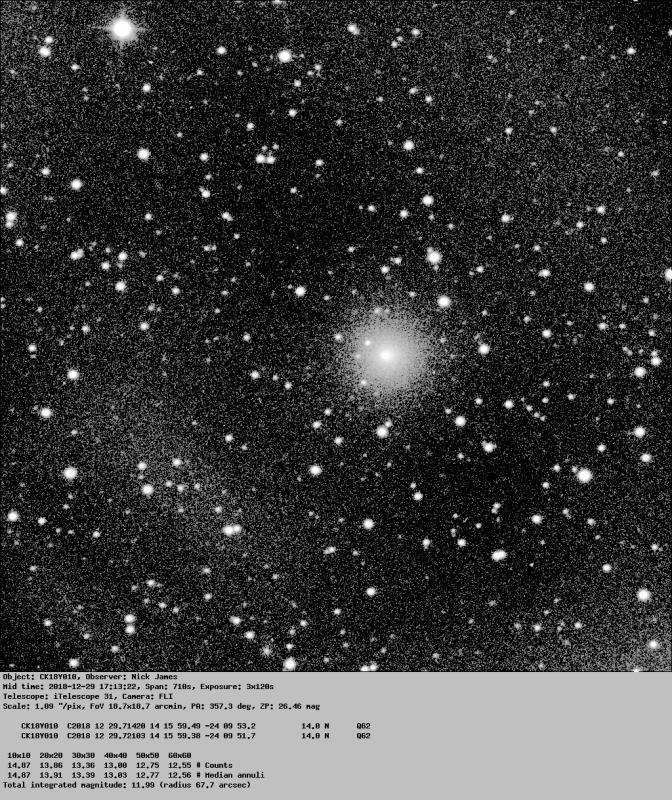2018 December 29
C/2018 Y1 (Iwamoto) – A new comet for the new year
Update: 2019 January 8. The latest astrometry means that we can now be fairly confident about the path that this comet will take across the sky. The uncertainty around the time of closest approach on February 12 is now only 10 arc minutes. These charts (2018y1_chart1.pdf, 2018y1_chart2.pdf, 2018y1_chart3.pdf, 2018y1_chart4.pdf) show the comet’s track over the next few weeks. Note in partcular the close approach to the nice barred spiral galaxy, M95, on the morning of February 11. If you have a camera with a field of view of 1.5 degs you should be able to get both in. It is still to early to say how bright the comet will be but if we are lucky it might reach magnitude 6 at closest approach. It is currently around mag 10.5.
For the second time in a couple of months the Japanese amateur Masayuki Iwamoto has discovered a comet. This one was picked up as it emerged from the solar glare into the morning sky. Iwamoto discovered the comet during his patrol in images taken on December 18.84 with a 10-cm aperture f/4.0 Pentax SDUF II apo refractor and a Canon EOS 6D camera. At discovery the comet was around 13th magnitude with a well condensed coma moving very slowly north near the Hydra/Libra border at a declination of 25 deg south. It has been designated C/2018 Y1 (Iwamoto) and it is heading for perihelion early next year.
The comet is currently moving very slowly relative to the stars and this has made computation of an accurate orbit difficult. We now have enough astrometry to make some reasonably accurate predictions of its track across the sky. The latest elements are:
Perihelion 2019 Feb 6.476542 +/- 0.348 TT; Constraint: e=1
Epoch 2018 Dec 29.0 TT = JDT 2458481.5 Earth MOID: 0.2907 Find_Orb
q 1.27871348 +/- 0.00523 (J2000 ecliptic)
M(N) 11.8 K 10.0 Peri. 357.90662 +/- 0.10
Node 147.12928 +/- 0.21
e 1.0 +/- 0 Incl. 160.44497 +/- 0.013
33 of 35 observations 2018 Dec. 18-29; mean residual 0″.67
At discovery the comet was 2.0 au from the Earth and 1.5 au from the Sun. At present it is at a declination of -24 deg and, from southern England, it is around 10 deg above the horizon as the sky begins to brighten rapidly at 0630 UT. It is therefore a challenge from the UK but I managed to image it on the morning of December 22. The comet is currently moving in to a perihelion at q=1.28 au on 2019 February 6. The Earth is just in the right position for the comet to make a close approach just after perihelion. On February 12 the comet is 1.28 au from the Sun and only 0.30 au from the Earth moving rapidly through the stars of Leo, perfectly placed high in a dark sky for northern hemisphere observers.
This chart (2018y1.pdf) shows the motion through January and early February. At closest approach on Feb 12 the positional uncertainty is currently around 2 degrees. The comet moves past quite a few deep-sky objects and so there is ample opportunity to get some good images. The total magnitude at the moment is around 12.0 and we might expect the magnitude to reach 6 at closest approach although this is currently very uncertain.
High quality observations are currently possible using remote telescopes in the southern hemisphere and we already have many images in the section archive.

| The British Astronomical Association supports amateur astronomers around the UK and the rest of the world. Find out more about the BAA or join us. |
